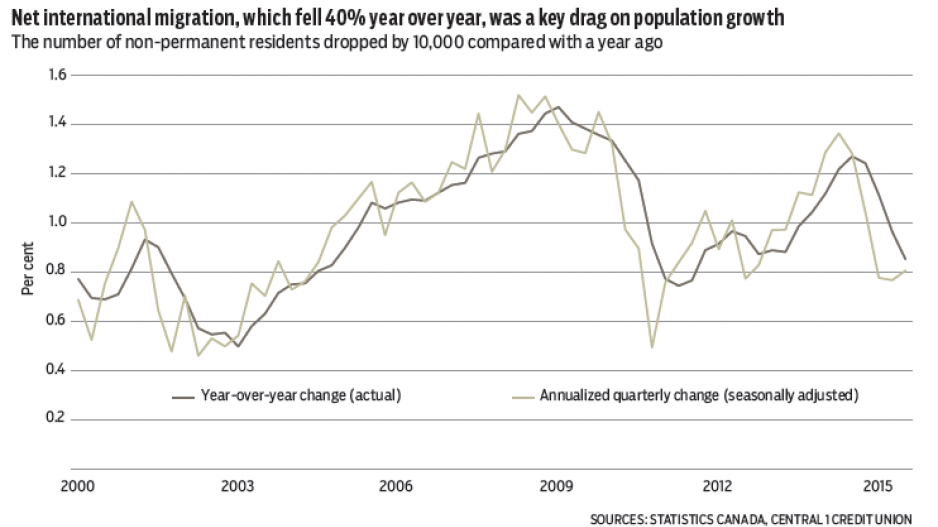The pattern of underwhelming population growth in B.C. continued into the third quarter. Estimated population reached 4.7 million as of October 1, marking a year-over-year gain of less than 0.9%, compared with 1% during the second quarter. Adjusted for seasonal factors, quarter-over-quarter growth held steady at a disappointing annualized pace of 0.8%
Net international migration was again the key drag on population growth, which fell to 11,100 persons during what is typically the most active quarter for migratory gains. This marked a 40% drop from the same quarter in 2014. However, this top-line figure is not as bad as it seems. The number of landed immigrants bounced back after a particularly weak first half and was up 33% on a same-quarter basis from a year ago. A drop of 10,000 net non-permanent residents from a year ago offset this increase.
Third-quarter uplift in permanent landed international immigration could signal that the first-half lull was temporary, but we are still unlikely to retrace to the trend observed from 2005-2010. Tempered global economic growth is dampening some interest from economic-class immigrants to make significant moves. Syrian refugee inflows are anticipated to provide a lift to B.C. in 2016, but the number is still an unknown.
Meanwhile, stronger economic conditions in B.C. compared with other provinces are driving interprovincial migration higher. Third-quarter net interprovincial migration jumped 74% from a year ago to 6,315 persons, owing to a strong increase in inflows. Seasonally adjusted, quarterly interprovincial migration was the strongest since 1996.
Central 1 forecasts population growth of about 1% in 2016 as interprovincial migration will continue to add to growth, but net international flows remain subdued.
Meanwhile, inbound international tourism flows in October remained high as a low Canadian dollar and improved economic conditions south of the border fuelled increased travel to B.C. Lifted by demand from U.S. tourists, total international visitors to the province climbed to a seasonally adjusted 412,190, up 0.4% from September and 4.8% from the same month in 2014.
Year-to-date, the total number of international visits was 7.6% higher than a year ago, led by a 9% U.S. gain. We anticipate current trends to hold through the end of the year, with further exchange rate depreciation fuelling year-end gains. The total number of inbound tourists will climb 7% this year to the highest level since 2005. A mild increase of about 3% is expected for 2016.•
Bryan Yu is senior economist at Central 1 Credit Union.




